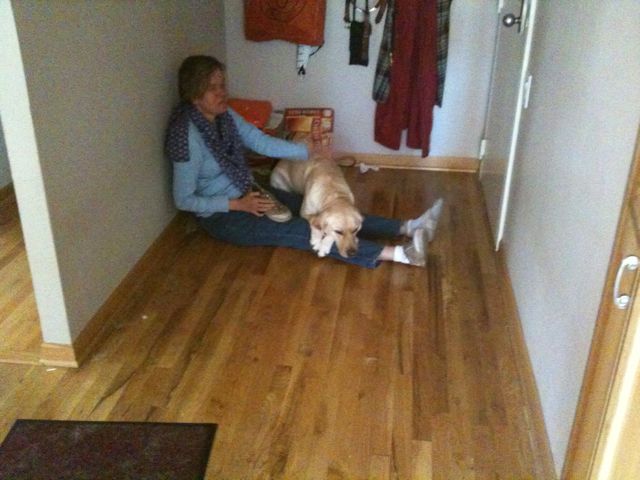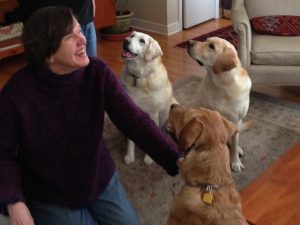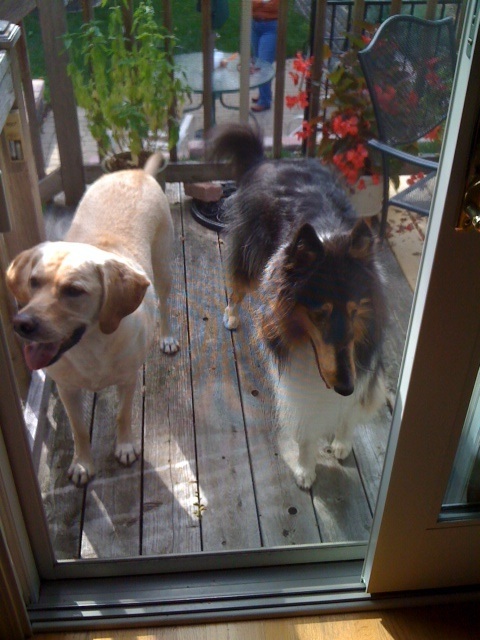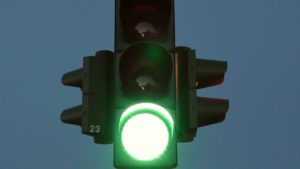Harper the Hero
October 9, 2011 • 65 Comments • Posted in Beth Finke, blindness, Mike Knezovich, Seeing Eye dogs, UncategorizedHarper is not the only heroic guy in the family – my husband Mike Knezovich is a hero, too. When I told him I’d have a hard time writing about this, he generously offered to write a guest post about it for me.
Harper the hero
by Mike Knezovich
So I was going to steal a line from Beth and call this post Harper’s Bizarre, because, well, he’s exhibited some really strange behavior over the past several months.
The thing is, if you were to watch Harper and Beth work inside and in the vicinity of our condo building you’d say he was terrific. Because he is. He’s uncanny at finding elevators, weaving through pedestrian traffic, and unbelievably gentle and polite when approaching slow walkers or WPs—wobbly people as we say in the guide dog parlance.
But.
Harper has developed a boundary line—a line only he sees or understands—past which he will not go. Literally. For example, he’ll cross our street—Dearborn—at a very busy intersection and take Beth to the tree where he does his emptying, and he won’t miss a beat. But he won’t cross the next street—a quiet side lane. On a good day, he will follow Beth’s command to walk south, a long city block to Polk Street, then turn right on Beth’s command to head north and back home.
He will not, however, go any farther away from home than that route. He simply stops. He can be literally dragged, but that’s all that will move him. And it’d take a stronger man than me to drag him much more than a yard. He’s one muscular dog.
It’s like this in other locales, too. That is, if I drive Beth to the Chicago Cultural Center, where Beth teaches, he’ll pile out of the car, Beth will grab his harness, and he’ll be off like a rocket up the ramp to the front door, and lead her precisely to her spot in the classroom inside the building. No mean feat, as the Cultural Center is a hulking structure. He’ll take her out of the Cultural Center, too. But only as far as is necessary to be picked up by me or a taxi. He will not venture down the busy city sidewalk to lead her home. Beth traveled to Madison, Wis., recently, and it was the same. She got a ride from Chicago to the front door of her hotel. He brought her to the registration desk. They were led to their room, and he routinely got her out of the hotel and back to the room without help. But he would not travel away from the hotel.
Beth and I have concluded sardonically that we’ve become guide people, service people, our mission in life is to make sure that Harper is able to travel safely with our help. A little gallows humor never hurts when dealing with sad subjects.
But ultimately, this is really sad, not funny. Harper is not bizarre, he’s a hero. And like a good many other heroes, his heroic act has left a lasting—if invisible—scar.
Here’s what happened: about two or three weeks after Beth and Harper came home from training, they were headed north on State Street. Beth waited to hear that traffic on State was moving—indicating that the light was green and she could cross—and she commanded Harper to go forward. They stepped into the street to cross.
A northbound vehicle didn’t see Beth and Harper and made a right turn into their path. Beth doesn’t remember any detail except being dragged backward—by Harper—yanked so hard that she fell to the pavement and hit her head. So hard that it bent and split the metal fitting on Harper’s harness where the handle attaches. (Even back in December during training, Harper had excelled at traffic checks—disobeying the command to go forward in the face of traffic and pulling Beth back if a vehicle darted in front of them.)
The woman driving the car pulled over and came, panicked, to Beth’s aid. She didn’t realize that the reason Beth had fallen backwards was due to Harper’s strength and determination to pull her away from the oncoming car. The driver was sure she’d hit Beth and Harper. Beth, to this day, isn’t absolutely sure whether Harper was brushed by the vehicle or not.
A pedestrian also came to Beth’s aid and asked what he could do for her. Beth asked whether Harper was OK—fully expecting to hear that Harper had been hit.
The pedestrian told her Harper was fine, helped Beth get her bearings, walked her and Harper across the street, and Beth and Harper made it home to tell me the story.
As it happened, Harper was not fine. He behaved normally for at least a couple weeks after the incident. But then, one day, weeks afterward, Beth was on her way to a meeting at her Easter Seals job in Willis Tower. Out of the blue, as they were cruising along Jackson Street, Harper stopped on the sidewalk. It wasn’t at an intersection. A passerby came to Beth’s aid. Beth asked if there was anything unusual—construction or whatever—going on. There was not.
The stranger gave Beth his elbow and walked her and Harper “sighted guide.” As soon as Harper saw Willis Tower—a familiar sight—he picked it up. But later, he kept doing this type of thing: balking, crouching, cowering in the middle of a block—for no apparent reason. He just didn’t want to go any farther.
After a visit from a Seeing Eye instructor, Beth got some great tips using clicker training and treats and Harper started to improve. It looked like he was going to make it.
Then Beth broke her foot.
For weeks she could only take Harper out once a day on harness. And that was only as far as his favorite tree. I’d take him the rest of the time. And that’s when we knew the problem was getting worse, not better. When I took him—or tried to take him—on a walk, he cowered and froze any time we went past his usual spot and on into unknown territory. And he wasn’t even working. He didn’t have his harness on. He knew
I was leading. And he still didn’t go.
I held onto the hope that it was because he knew Beth was back at home, and he didn’t want to go any farther away from her than necessary. The last hope was lost after Beth’s foot healed and she got the doctor’s green light to start walking as far as she wanted to. Where before, a clicker and a treat would get him going, now Harper—a Yellow Labrador Retriever mind you—was not motivated by treats.
The Seeing Eye sent another instructor out our way. Chris spent a couple days with us and Harper. He tried the clicker/treat routine and witnessed what we had. He said he’d never ever seen a Lab who didn’t want a treat badly enough to obey a command.
We talked a lot with Chris, and he said that although the training at the Seeing Eye includes a trip or two to New York City with the trainer, then another with the person they are eventually matched with—there’s really no way to know for sure how a dog will react to city surroundings—or any surroundings, for that matter—in the long term.
He also explained that although Harper didn’t start balking right after the near-miss with the car, the stresses on the dogs can be cumulative.
The three of us talked and imagined what swirled around in Harper’s head. In the end, Chris made it clear that city life had just become too much for Harper. Beth would have to get matched with a new partner. We all agreed that Harper would stay with us at least until Beth could go to another class. He’s still good at what he is able to do, as long as we can provide door-to-door transportation. And we’re more attached to him than ever. As for Harper’s future, Chris said he’d talk with his colleagues when he got back to New Jersey about whether Harper could be retrained and perhaps work in a calmer environment.
We doubted he could, and silently hoped—for Harper’s sake—that he’d be able to spend his years as a plain old dog. But we also hated the idea that all that training, and all Harper’s gentle ways, would be wasted.
Well, we needn’t have worried. Last week John Keane—the Seeing Eye’s head of training—called Beth. He made clear that there was no intention to retrain Harper.
And John drove home that the Seeing Eye’s hard work and Harper’s training were hardly wasted.
“He took a bullet for you,” John said. “And for that he earned an early retirement.”






